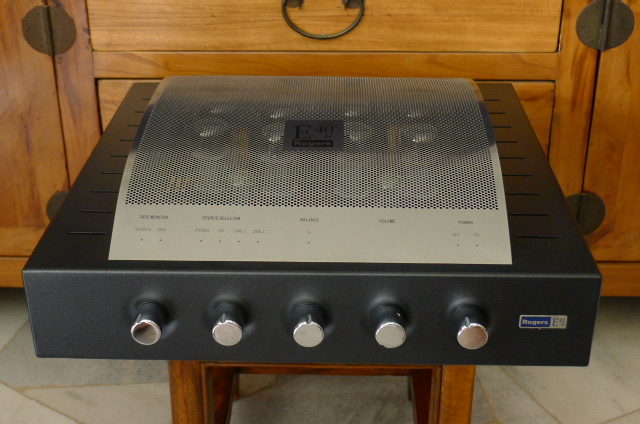
The faceplate has, from left to right, four toggle switches (power on/off, standby, mode, and input) along the lower part, with a blue information window on the upper part. (I’d welcome more color departures from black chassis. I thought the combination of the brushed aluminum faceplate and transformer trim plate with the red paint on the chassis looked quite elegant and attractive. The red color is not a garish, bright hue, but sort of a candy apple red. In a departure from the norm, the chassis is painted red instead of the usual Boring Black.

Rogers audionote integrated tube amplifier full#
The Corona is built on a wide, flat chassis with a silver, brushed-aluminum faceplate in the front, tubes in the central area, and in the rear a transformer that spans the full width of the chassis. The Corona has the typical integrated amp advantages: It requires no preamp-to-amp interconnect, and it occupies just a single shelf, albeit a very sturdy, well-ventilated shelf. Rogers makes a very interesting phono preamp, the PA-2, which is definitely worthwhile considering to match to the Corona, but doesn’t offer a DAC or headphone amp. You know exactly which of those units suits your system, and don’t want to waste money on the type of limited or compromised integral DAC, phono preamp, or headphone amp that’s typically included in some integrated amps. This makes sense to me if you’re willing to shell out $15,000 for the Corona, you’re probably a very serious listener who wants an advanced stand-alone DAC, phono preamp, and headphone amp. There’s no DAC, no phono preamp, no headphone amp. The Corona deliberately leaves out features that can be found on several other integrated amps. Just specify when you buy the amp which output tubes you want. Rogers High Fidelity’s new Corona KWM-88 integrated amplifier’s automatic bias circuitry makes it possible to switch between KT88s and KT150s. Just insert the new tubes and the bias circuitry changes the necessary parameters. So if an amplifier is shipped with E元4s, you can change them to KT88s and the automatic-bias circuit will adjust the bias to suit the KT88s with no adjustment from the user.

Those circuits make it feasible to switch easily between different types of tubes. One of the more recent computerized hi-fi circuits sets the bias current of the output tubes on tube amplifiers. An optional all-valve phono stage, using ECC83 tubes, is available. The price is £4,999 for line only and £5,499 with MM phono stage.Your car is full of computers that make it eas ier to operate and maintain why shouldn’t your hi-fi follow suit? Increasingly, that’s what’s happening.
Rogers audionote integrated tube amplifier driver#
The striking burgundy finish was chosen to make reference to the vintage Rogers amplifiers of the 1960s. Originally designed by Audio Note for Rogers, the Limited Edition version is in MkII form and features a revised phase-splitter and driver design featuring a pair of 6SN7 valves and an ECC83. Rogers distributor Retrotone, based in Sittingbourne, bought the components and set about assembling all the parts needed to re-create this classic E40A from the 90’s. "They were just sitting in Audio Note’s store room", says Andy Whittle, "and it was too good an opportunity to pass up." Rogers have announced a strictly-limited edition of their E40AiiLE integrated valve amplifier. The pure Class-A tube amp's production run will be restricted to just ten units, and comes about only by chance. While working at Audio Note, Rogers' Head of Design unearthed a handful of chassis transformers and PCB’s for this highly-revered amplifier.


 0 kommentar(er)
0 kommentar(er)
